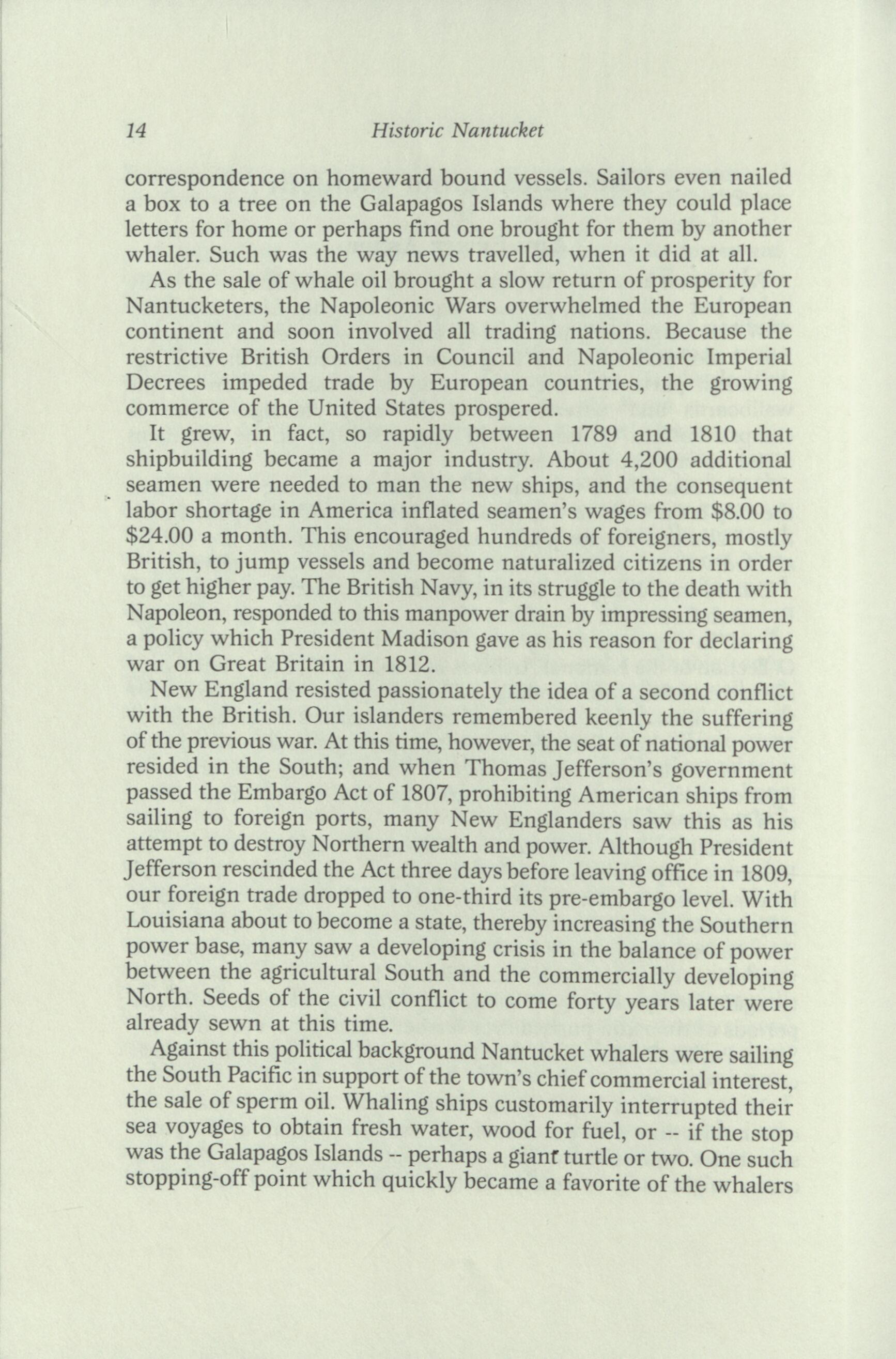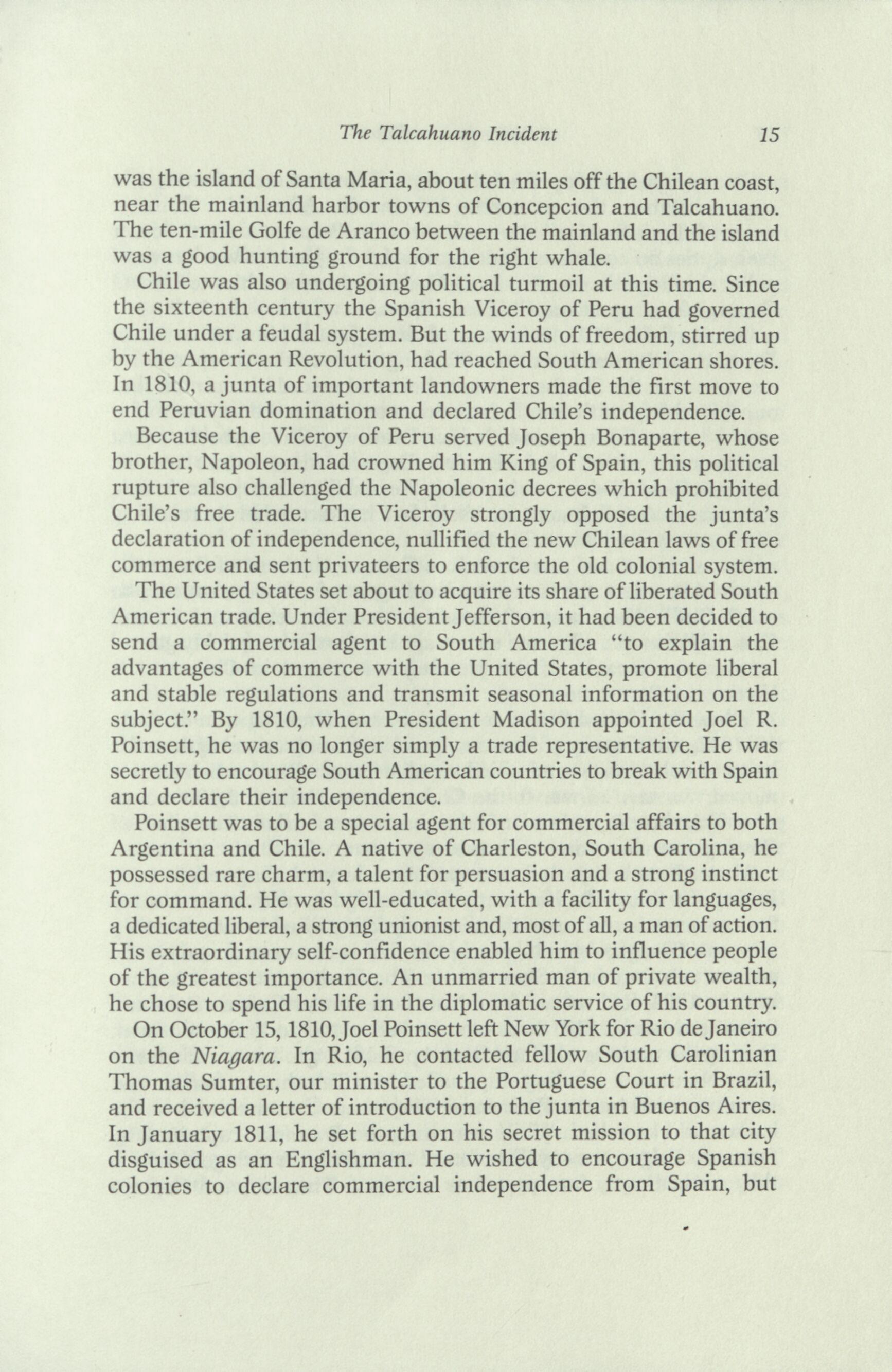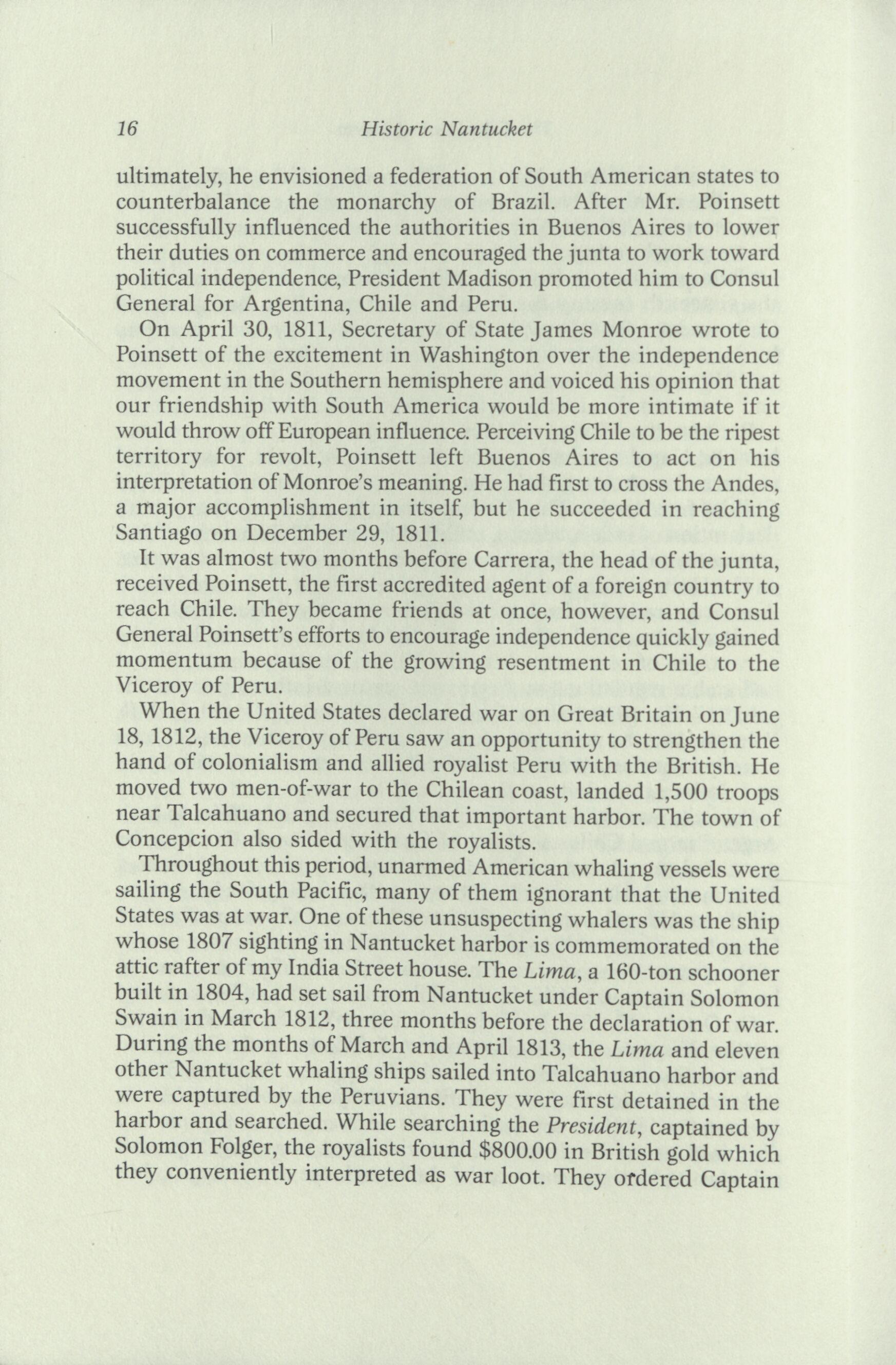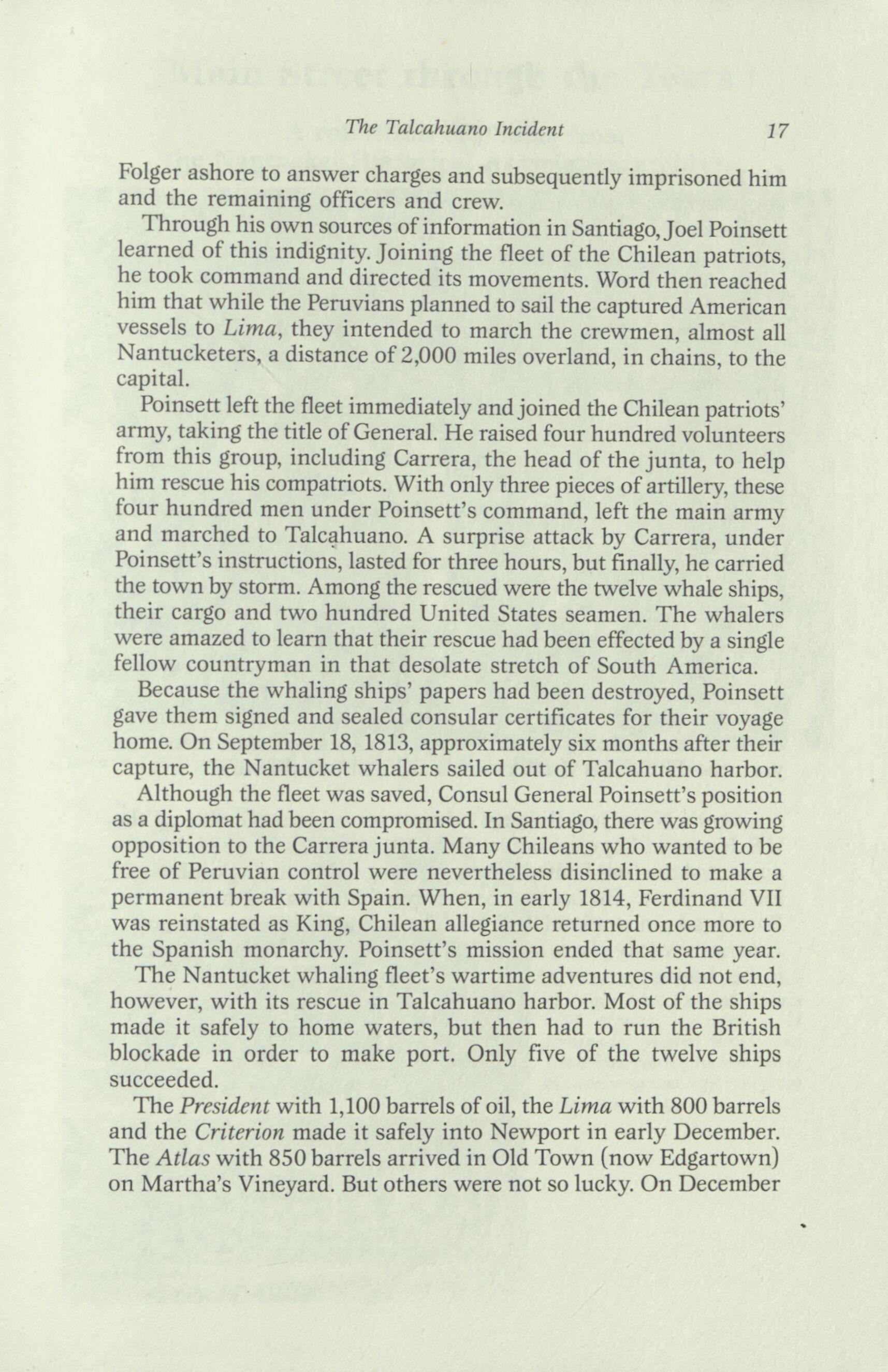
9 minute read
My Seafaring Family, Chapter
14 Historic Nantucket
correspondence on homeward bound vessels. Sailors even nailed a box to a tree on the Galapagos Islands where they could place letters for home or perhaps find one brought for them by another whaler. Such was the way news travelled, when it did at all.
As the sale of whale oil brought a slow return of prosperity for Nantucketers, the Napoleonic Wars overwhelmed the European continent and soon involved all trading nations. Because the restrictive British Orders in Council and Napoleonic Imperial Decrees impeded trade by European countries, the growing commerce of the United States prospered.
It grew, in fact, so rapidly between 1789 and 1810 that shipbuilding became a major industry. About 4,200 additional seamen were needed to man the new ships, and the consequent labor shortage in America inflated seamen's wages from $8.00 to $24.00 a month. This encouraged hundreds of foreigners, mostly British, to jump vessels and become naturalized citizens in order to get higher pay. The British Navy, in its struggle to the death with Napoleon, responded to this manpower drain by impressing seamen, a policy which President Madison gave as his reason for declaring war on Great Britain in 1812.
New England resisted passionately the idea of a second conflict with the British. Our islanders remembered keenly the suffering of the previous war. At this time, however, the seat of national power resided in the South; and when Thomas Jefferson's government passed the Embargo Act of 1807, prohibiting American ships from sailing to foreign ports, many New Englanders saw this as his attempt to destroy Northern wealth and power. Although President Jefferson rescinded the Act three days before leaving office in 1809, our foreign trade dropped to one-third its pre-embargo level. With Louisiana about to become a state, thereby increasing the Southern power base, many saw a developing crisis in the balance of power between the agricultural South and the commercially developing North. Seeds of the civil conflict to come forty years later were already sewn at this time.
Against this political background Nantucket whalers were sailing the South Pacific in support of the town's chief commercial interest, the sale of sperm oil. Whaling ships customarily interrupted their sea voyages to obtain fresh water, wood for fuel, or - if the stop was the Galapagos Islands - perhaps a giant turtle or two. One such stopping-off point which quickly became a favorite of the whalers
The Talcahuano Incident 15
was the island of Santa Maria, about ten miles off the Chilean coast, near the mainland harbor towns of Concepcion and Talcahuano. The ten-mile Golfe de Aranco between the mainland and the island was a good hunting ground for the right whale.
Chile was also undergoing political turmoil at this time. Since the sixteenth century the Spanish Viceroy of Peru had governed Chile under a feudal system. But the winds of freedom, stirred up by the American Revolution, had reached South American shores. In 1810, a junta of important landowners made the first move to end Peruvian domination and declared Chile's independence.
Because the Viceroy of Peru served Joseph Bonaparte, whose brother, Napoleon, had crowned him King of Spain, this political rupture also challenged the Napoleonic decrees which prohibited Chile's free trade. The Viceroy strongly opposed the junta's declaration of independence, nullified the new Chilean laws of free commerce and sent privateers to enforce the old colonial system.
The United States set about to acquire its share of liberated South American trade. Under President Jefferson, it had been decided to send a commercial agent to South America "to explain the advantages of commerce with the United States, promote liberal and stable regulations and transmit seasonal information on the subject." By 1810, when President Madison appointed Joel R. Poinsett, he was no longer simply a trade representative. He was secretly to encourage South American countries to break with Spain and declare their independence.
Poinsett was to be a special agent for commercial affairs to both Argentina and Chile. A native of Charleston, South Carolina, he possessed rare charm, a talent for persuasion and a strong instinct for command. He was well-educated, with a facility for languages, a dedicated liberal, a strong unionist and, most of all, a man of action. His extraordinary self-confidence enabled him to influence people of the greatest importance. An unmarried man of private wealth, he chose to spend his life in the diplomatic service of his country.
On October 15,1810, Joel Poinsett left New York for Rio de Janeiro on the Niagara. In Rio, he contacted fellow South Carolinian Thomas Sumter, our minister to the Portuguese Court in Brazil, and received a letter of introduction to the junta in Buenos Aires. In January 1811, he set forth on his secret mission to that city disguised as an Englishman. He wished to encourage Spanish colonies to declare commercial independence from Spain, but

16 Historic Nantucket
ultimately, he envisioned a federation of South American states to counterbalance the monarchy of Brazil. After Mr. Poinsett successfully influenced the authorities in Buenos Aires to lower their duties on commerce and encouraged the junta to work toward political independence, President Madison promoted him to Consul General for Argentina, Chile and Peru.
On April 30, 1811, Secretary of State James Monroe wrote to Poinsett of the excitement in Washington over the independence movement in the Southern hemisphere and voiced his opinion that our friendship with South America would be more intimate if it would throw off European influence. Perceiving Chile to be the ripest territory for revolt, Poinsett left Buenos Aires to act on his interpretation of Monroe's meaning. He had first to cross the Andes, a major accomplishment in itself, but he succeeded in reaching Santiago on December 29, 1811.
It was almost two months before Carrera, the head of the junta, received Poinsett, the first accredited agent of a foreign country to reach Chile. They became friends at once, however, and Consul General Poinsett's efforts to encourage independence quickly gained momentum because of the growing resentment in Chile to the Viceroy of Peru.
When the United States declared war on Great Britain on June 18, 1812, the Viceroy of Peru saw an opportunity to strengthen the hand of colonialism and allied royalist Peru with the British. He moved two men-of-war to the Chilean coast, landed 1,500 troops near Talcahuano and secured that important harbor. The town of Concepcion also sided with the royalists.
Throughout this period, unarmed American whaling vessels were sailing the South Pacific, many of them ignorant that the United States was at war. One of these unsuspecting whalers was the ship whose 1807 sighting in Nantucket harbor is commemorated on the attic rafter of my India Street house. The Lima, a 160-ton schooner built in 1804, had set sail from Nantucket under Captain Solomon Swain in March 1812, three months before the declaration of war. During the months of March and April 1813, the Lima and eleven other Nantucket whaling ships sailed into Talcahuano harbor and were captured by the Peruvians. They were first detained in the harbor and searched. While searching the President, captained by Solomon Folger, the royalists found $800.00 in British gold which they conveniently interpreted as war loot. They ordered Captain

The Talcahuano Incident 17
Folger ashore to answer charges and subsequently imprisoned him and the remaining officers and crew.
Through his own sources of information in Santiago, Joel Poinsett learned of this indignity. Joining the fleet of the Chilean patriots, he took command and directed its movements. Word then reached him that while the Peruvians planned to sail the captured American vessels to Lima, they intended to march the crewmen, almost all Nantucketers, a distance of 2,000 miles overland, in chains, to the capital.
Poinsett left the fleet immediately and joined the Chilean patriots' army, taking the title of General. He raised four hundred volunteers from this group, including Carrera, the head of the junta, to help him rescue his compatriots. With only three pieces of artillery, these four hundred men under Poinsett's command, left the main army and marched to Talcahuano. A surprise attack by Carrera, under Poinsett's instructions, lasted for three hours, but finally, he carried the town by storm. Among the rescued were the twelve whale ships, their cargo and two hundred United States seamen. The whalers were amazed to learn that their rescue had been effected by a single fellow countryman in that desolate stretch of South America.
Because the whaling ships' papers had been destroyed, Poinsett gave them signed and sealed consular certificates for their voyage home. On September 18, 1813, approximately six months after their capture, the Nantucket whalers sailed out of Talcahuano harbor.
Although the fleet was saved, Consul General Poinsett's position as a diplomat had been compromised. In Santiago, there was growing opposition to the Carrera junta. Many Chileans who wanted to be free of Peruvian control were nevertheless disinclined to make a permanent break with Spain. When, in early 1814, Ferdinand VII was reinstated as King, Chilean allegiance returned once more to the Spanish monarchy. Poinsett's mission ended that same year.
The Nantucket whaling fleet's wartime adventures did not end, however, with its rescue in Talcahuano harbor. Most of the ships made it safely to home waters, but then had to run the British blockade in order to make port. Only five of the twelve ships succeeded.
The President with 1,100 barrels of oil, the Lima with 800 barrels and the Criterion made it safely into Newport in early December. The Atlas with 850 barrels arrived in Old Town (now Edgartown) on Martha's Vineyard. But others were not so lucky. On December

18 Historic Nantucket
14, 1813, a small schooner off Siasconset landed forty prisoners, all whalemen. They were the crew of the Gardner, captured when near safety by the British ship Loire, and the crew of the Monticello, taken a few days earlier off the Delaware Cape. The Chile, carrying 550 barrels of oil, came within sight of Nantucket but diverted to Martha's Vineyard where it was in port only two hours before being taken by the British ship Nimrod. The Perserveranda had just made the turn at Tuckernuck shoal when a British seventy-four captured it ten miles out of port.
I do not know what happened to the Lion, the Sukey, the John and James or the Mary Ann, but they did not make it home. The Charles, unlike the other ships, stayed nonchalantly to continue whaling in the South Pacific. It arrived safely in Nantucket on February 27,1814, with "the most valuable cargo of oil ever brought here."
The ship Lima, which had brought me originally to the story of the Talcahuano incident, made three other successful whaling expeditions to the South Pacific between 1815 and 1823. During its penultimate voyage, however, pirates boarded and plundered it. It set sail from Nantucket for the last time on May 31, 1842, almost exactly thirty-five years after the unknown occupant of my house had recorded its sighting in the harbor. In mid-Atlantic, it suffered the ill omen of losing its third mate, Asa Gardner, and that same year, the Lima was condemned in Rio, outward bound.

Editor's Note: Joel Roberts Poinsett served as a member of the U.S. House of Representatives from 1821 to 1825. In 1825, he was appointed the first United States minister to Mexico, a post he held for four years. He became Secretary of War during Martin Van Buren's administration (1837-41). The poinsettia, a genus of tropical American woody plants he introduced to the United States, is named in his honor.




